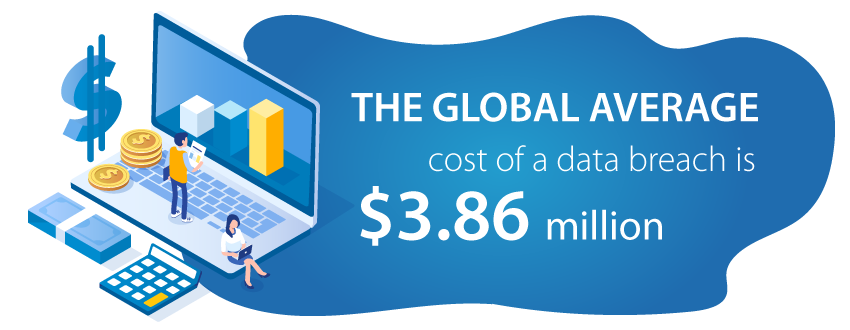
With new corporate data breaches in the news seemingly every day, it’s no surprise that security is a top concern for IT professionals. However, file transfers are an area where many companies are still vulnerable.
Most file transfers still use FTP, a protocol that comes with inherent risks. Other common file transfer solutions, like file sharing apps, come with their own security concerns.
This is the second in a series of articles about the ROI of managed file transfer (MFT), the first of which covered time savings with MFT. There’s no doubt that data breaches are costly. Data Insider put the average cost in 2019 at $8.19 million. So it’s a no-brainer that a solution to secure your file transfers would bring you a great return on investment.
And yet, when you try to get internal approval for products to help with security, proving the ROI can be difficult. A good security tool is by nature preventative. If you haven’t suffered a breach (or you have and don’t know about it yet), you probably don’t have a way to precisely calculate cost-savings.
Still, your data certainly has value, and you know you have to keep it secure. So how do you know you are protecting your file transfers with the solution that gives you the most bang for your buck? By making sure the software you choose addresses all of the top file transfer security concerns within one solution—no additional purchases or custom scripting required.
A Variety of Secure Protocols
FTP has been proven vulnerable to hacking and it’s essential for modern enterprises to turn to more modern and secure file transfer methods, such as:
- AS2: AS2 generates an "envelope" for the data, allowing it to be sent using digital certifications and encryption.
- SFTP and FTPS: These secure FTP protocols bring down the risk during data exchange by using a secure channel between computer systems
- HTTPS: The secure version of HTTP, HTTPS encrypts communications between browser and website.
Which of these methods your company implements may depend on several factors, like your industry compliance requirements or what your trading partners use. Your requirements may also change over time. That’s why the best investment is a versatile managed file transfer solution that can handle any of these protocols and more.
Protection Against People
When you imagine the security threat to your company, you might conjure up images of hackers working tirelessly to access your systems and use your data for nefarious purposes. The truth is, one of your biggest threats is probably in the office down the hall.
A report by CNBC found that 47% of business leaders said human error was the source of data loss. Half of this is intentional—disgruntled or opportunistic employees, contractors, or suppliers performing deliberate acts of data theft. But half of it is accidental. People like to cut corners, and probably most employees in your company aren’t as concerned about security as you are.
Related Reading: 6 Users to Put on Your Security Watch List
Any file transfer solution with a good ROI has to address the threat coming from within the business. You want to have role-based security options that limit each user to the servers and the functions of managed file transfer that they absolutely need to use. Detailed audit logs mean you always know who is doing what with the solution.
Ensure Compliance
In many industries, inadequate security practices don’t just put your own corporate data at risk, they can endanger highly sensitive information like credit card numbers and health records. For this reason, a number of compliance requirements exist to protect personal data. A few of the most common are PCI DSS, Sarbanes-Oxley, and HIPAA, but your industry may have others.
Compliance costs for organizations are between $7.7 million and $30.9 million, half the cost of a data breach. In the case of file transfers, your MFT platform should have a number of encryption methods available to protect sensitive data including SSL, SSH, AES, and Open PGP encryption. Audit trails should also be in place to track file transfer activity so you can easily determine what files are being sent, what time they are sent, and who the sender and receiver are.
Modernization and Scalability
Once you go to the effort of choosing a file transfer solution that will protect your company, convince management of its necessity, and implement the software, the last thing you want to have to do is change it two years down the road because your company is bigger, has more compliance requirements, or new trading partners.
A managed file transfer platform from an established, reliable software provider will make sure you stay updated with the features necessary to combat current security threats. Furthermore, if your volume of file transfers increases, you won’t need to invest in a new tool to handle the workload.
Increased Productivity
If your managed file transfer solution can prevent a data breach, that alone makes it worth the investment. But what if it could increase productivity and reduce errors at the same time? The automation capabilities of managed file transfer software allow you to make a high volume of file transfers without the need for tedious manual work. Streamlining this process—and eliminating the risk of human error—add to your organization’s bottom line.
Looking for a Reliable MFT Solution?
Read more about safeguarding company data and limiting risk, or get started!
